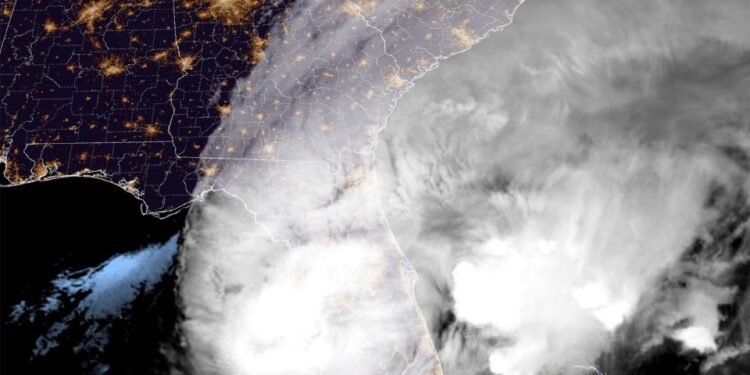HURRICANE Milton has made landfall in Florida – with locals braced for devastating storm surges of up to 15 feet.
The catastrophic storm brought winds of 120mph with officials warning the danger is not over.
The Florida Division of Emergency Management said: “Residents should continue to shelter in place & remain vigilant.”
The first casualties were reported in the Spanish Lakes area of Fort Pierce after tornadoes battered the state before Milton made landfall.
Shortly before the hurricane made landfall, Florida Governor Ron DeSantis urged: “You have to shelter in place and just hunker down.”
He added: “Unfortunately there will be fatalities.
“I don’t think there’s any way around that.”
Earlier, President Joe Biden called Milton “one of the most destructive hurricanes in Florida in over a century,” adding: “It’s a matter of life and death, and that’s not hyperbole.”
Pop star Taylor Swift pledged $5million to help with the relief effort after the hurricane has passed.
Dramatic footage showed entire palm trees ripped from their trunks, while in a clip by the NOAA, the storm caused massive 30ft waves.
State lawmakers fear Milton will be one of the worst and most destructive hurricanes in Florida in 100 years.
In the days leading up to the storm’s arrival, millions across west-central Florida stocked up their vehicles with essential items and personal belongings, driving north or south away from Milton’s intimidating path.
Eerie videos circulating on social media showed dozens of abandoned communities, many of which are still in ruins from the onslaught of Hurricane Helene two weeks ago.
In Gulfport, police drove slowly through a debris-riddled neighborhood, playing a recording on the loudspeaker informing residents of a mandatory evacuation, according to a video by reporter Brian Entin on X.
Mandatory evacuation orders are in place for 13 counties in Florida, including Sarasota, Hillsborough, and Volusia.
Aerial images showed Interstate 75’s northbound lane jam-packed with bumper-to-bumper traffic as hundreds of terrified residents fled their homes to seek shelter.
It comes as…
Dr. Michael Brennan, director of the US National Hurricane Centre, earlier warned that “a very dangerous situation is going to play out from west to east across the Florida peninsula.”
He added that a “life-threatening storm surge is about to play out along the Florida west coast.
Water will also be “violently pushed onto dry land” by the hurricane, up to 10ft above ground level.
“The water is now starting to rise, winds are picking up, rainfall is occurring and your evacuation routes may be cut off.”
He continued: “Much of the central portion of the peninsula… is at risk of devastating hurricane-force winds, especially in gusts over the inland areas that can cause structural damage, tree damage and widespread power outages.”
‘SIGNIFICANT COASTAL CHANGE’
Scientists at the US Geological Survey fear that Milton could completely change Florida’s west coastline forever.
“The significance of the coastal change forecast for Milton’s impact to the Florida west coast cannot be overstated as I believe communities are more vulnerable to this storm’s impacts due to the erosion that occurred recently from Helene,” Kara Doran, a USGS scientist, said.
“Our initial analysis looking at imagery collected by the National Oceanic and Atmospheric Administration after Helene shows most of the west coast experienced overwash or inundation and complete erosion of dunes, so those protective dunes are no longer in place for many locations.”
Experts predict Milton’s ferocious storm surge could cause 95% to 100% of Florida’s west coast beaches to experience erosion and overwash.
Overwash occurs when water levels reach higher than the top of the dunes.
When a beach is overwashed, sand can be pushed and deposited inland, causing significant changes to coastal landscapes and blocking roadways, according to the USGS.
‘WHISKER SHY’ OF CATEGORY 5
Florida Governor Ron DeSantis described Milton as “just a whisker shy” of Category 5.
“While there is the hope that it will weaken more before landfall, there is high confidence that this hurricane is going to pack a major, major punch and do an awful lot of damage,” DeSantis told reporters on Wednesday.
Hours before Milton neared landfall, the storm spawned at least 10 tornados across southcentral Florida.
Florida is still reeling from the aftermath of Hurricane Helene in late September, which has left over 220 people dead across the southeast United States.
What is a hurricane and how do they form?
A HURRICANE is another name for a tropical cyclone – a powerful storm that forms over warm ocean waters near the equator.
Those arising in the Atlantic or eastern Pacific are called hurricanes, while those in the western Pacific and Indian Ocean are dubbed typhoons or cyclones.
North of the equator they spin anticlockwise because of the rotation of the Earth, however, they turn the opposite way in the southern hemisphere.
Cyclones are like giant weather engines fuelled by water vapor as it evaporates from the sea.
Warm, moist air rises away from the surface, creating a low-pressure system that sucks in air from surrounding areas – which in turn is warmed by the ocean.
As the vapour rises it cools and condenses into swirling bands of cumulonimbus storm clouds.
The system grows and spins faster, sucking in more air and feeding off the energy in seawater that has been warmed by the sun.
At the center, a calm “eye” of the storm is created where cooled air sinks towards the ultra-low pressure zone below, surrounded by spiraling winds of warm air rising.
The faster the wind, the lower the air pressure at the center, and the storm grows stronger and stronger.
Tropical cyclones usually weaken when they hit land as they are no longer fed by evaporation from the warm sea.
But they often move far inland – dumping vast amounts of rain and causing devastating wind damage – before the “fuel” runs out and the storm peters out.
Hurricanes can also cause storm surges when the low air pressure sucks the sea level higher than normal, swamping low-lying coasts.
























